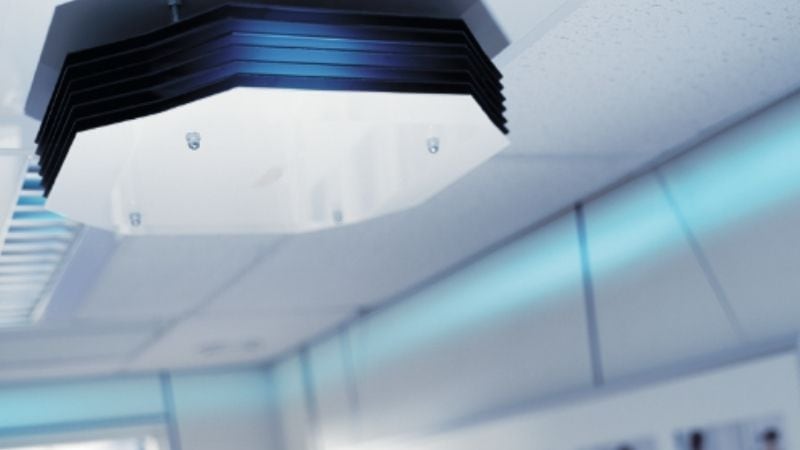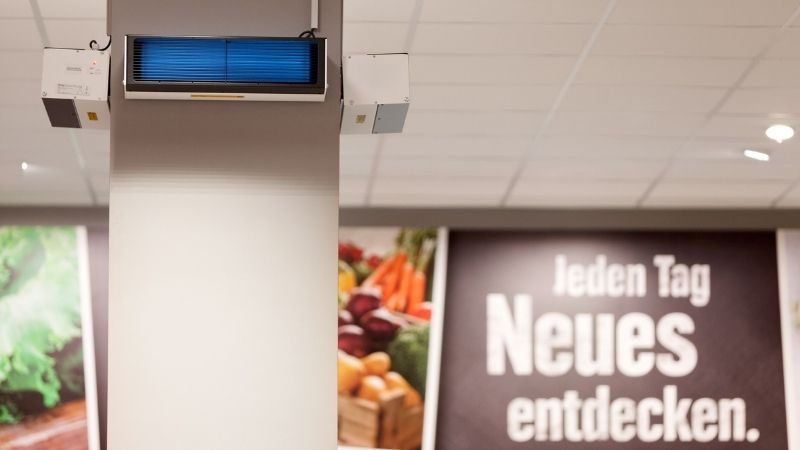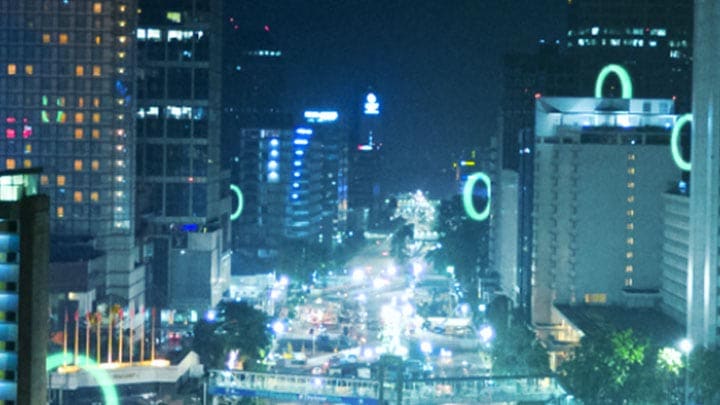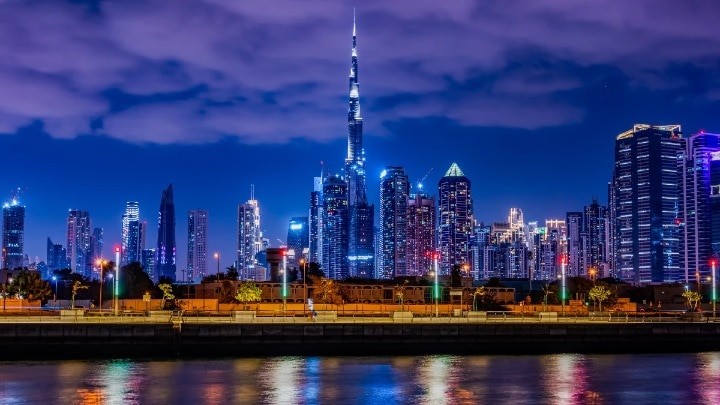June 21, 2021
Does UV-C air disinfection offer a guiding light to a post-pandemic world?
Mosquito-born malaria derives its name from mal aria, which is Medieval Italian for 'bad air'. According to the Ancient Romans and Greeks, malaria originated from pestilential fumes in swamps or fissures in the ground. It wasn’t until the 1880s that it was discovered that the disease came from mosquito bites.
This goes to show that it can take a long time to overturn conventional beliefs, even in the face of contradictory evidence. We can see this today when examining the early advice on dealing with the transmission of SARS-CoV-2, the virus causing COVID-19.
Until only a few months ago, the perceived wisdom was that SARS-CoV-2 spread by respiratory droplets expelled from the mouth. The droplets then fall to the ground contaminating surfaces and people in close contact with each other. It was widely believed that the virus made its way to our hands, then our noses, eyes, or mouths. Hence the need to regularly wash our hands and to avoid touching our face or mask and the requirement for social distancing.
Of course, transmission like this can occur and handwashing and masks are necessary, but what was overlooked was mounting evidence that the virus was also transmissible by aerosols, just like measles or tuberculosis. But back in 2020, advice from the World Health Organization focused on heavier, short-range droplets being the main culprit. The need to ventilate rooms and the importance of airflow seemed to be secondary considerations at best.
Thankfully, we now know that aerosol particles represent a primary route for the transmission of the SARS-CoV-2 virus. Both the World Health Organization and US Centers for Disease Control and Prevention (US CDC) have confirmed research findings and recently updated their guidance. This is because the virus can literally float through the air and be breathed in. Good ventilation and “clean air” are therefore essential, as are ways to disinfect the air.
Air disinfection is doubly important given the first tentative steps being taken to open up schools, shops, restaurants, gyms, and indoor events. Opening windows to reduce pathogens does help and typically it may result in one air change per hour. This can remove around 63% of pathogens from a room in one hour1. Yet such ventilation falls far short of effective disinfection, which may require removal of 99.99% of pathogens, and is not always feasible or possible, particularly inside modern office blocks.

One technology attracting a lot of interest is ultraviolet C (UV-C) lamps and luminaires. This technology is already being used inside ventilation and air conditioning systems and for a host of disinfection applications for air, surfaces and water. At the wavelength of 254 nanometers, UV-C light can inactivate viruses, bacteria, and mold by breaking down their DNA and RNA, rendering them harmless2. Small UV-C disinfection lamps inside heating, ventilation and air-conditioning units prevent the build-up of microorganisms and film on critical components such as on the evaporator coils. Disinfection of the coil makes these units more efficient, therefore saving electricity, while lowering maintenance costs.
“Most HVAC and ventilation systems are capable, by themselves, of providing up to two air changes per hour, which is insufficient for fast disinfection needed for many practical applications,” says Maurice Maes, Head of Standards and Regulation at Signify’s Innovation team.
Generally speaking, the more air changes per hour the better. Offices should really seek the equivalent of 15 to 20 air changes per hour – which is roughly the same as a commercial passenger jet.
And it can be done easily: the equivalent to 20 air changes per hour and higher can be achieved by UV-C disinfection upper air luminaires. Equipped with shielding and attached high enough on a wall or ceiling (in accordance with applicable safety standards), so as to avoid direct exposure to people or animals3, these silent, unobtrusive systems create a zone of UV-C energy that disinfects the air in a highly efficient and fast manner, leveraging the natural convection of air in a room. Below, people can literally go about their daily business as the air above them is disinfected.
The effectiveness of UV-C disinfection upper air systems against the SARS-CoV-2 virus is not in dispute. Tests performed with Innovative Bioanalysis in a Certified Safety Reference Laboratory in Costa Mesa, California, found that Philips UV-C disinfection upper air luminaires inactivated 99.99% of SARS-CoV-2 in the air of a room3 within 10 minutes, and the virus was below detectable levels at 20 minutes4. “This implies that in this experiment, about 50 equivalent air changes per hour were realized,” explains Maes, “and our modeling shows that many of our commercially installed UV-C upper air installations will be realizing between 15 and 30 equivalent air changes per hour.”
Given the results, it’s hardly surprising that the technology is being rolled out across the world and can now be found inside public spaces such as supermarkets, gyms, bars and offices, and even in the dressing rooms of top-flight soccer clubs such as RB Leipzig and PSV Eindhoven.

Sadly, the specter of COVID-19 is not going away anytime soon. The ‘Indian variant’ (Delta variant) is now the dominant strain in COVID-19 infections in the United Kingdom – a country with an advanced vaccination program. Other virus strains of interest are emerging as SARS-CoV-2 mutates further. Health professionals now suspect that it is most likely that we will live with COVID-19 variants for years and vaccines will have to be regularly tweaked, similar to today’s influenza vaccines.
Again, UV-C disinfection technology offers more than a glimmer of hope as it has an enviable track record against all pathogens tested in laboratories to-date. A fact not lost on Sam Kabbani, Chief Scientific Officer at Innovative Bioanalysis, who said, “Based on the understood method by which UV-C exposure deactivates pathogens, we would expect UV-C disinfection lighting to have a similar impact on the various genetic mutations of (SARS-CoV2).5”
The reality is that it is unlikely there is a single silver bullet to irradicate COVID-19. Vaccinations, handwashing, masks, and chemical disinfectants all continue to play their part. Now that we know that aerosols are a key form of transmission, we have in UV-C upper air disinfection a guiding light towards the end of the tunnel.
2 Malayeri et al 2016, Fluence (UV dose) required to achieve incremental log inactivation of bacteria protozoa viruses and algae
3 As UV-C light is a powerful disinfectant, it is important that people, animals, and plants are not directly exposed to the light source as it can harm their skin and eyes and can damage the leaves of plants.
For editorial enquiries:
Signify Global Integrated Communications
Neil Pattie
Tel: + 31 6 15 08 48 17
Email: neil.pattie@signify.com
Signify (Euronext: LIGHT) is the world leader in lighting for professionals, consumers and the Internet of Things. Our Philips products, Interact systems and data-enabled services, deliver business value and transform life in homes, buildings and public spaces. In 2023, we had sales of EUR 6.7 billion, approximately 32,000 employees and a presence in over 70 countries. We unlock the extraordinary potential of light for brighter lives and a better world. We have been in the Dow Jones Sustainability World Index since our IPO for seven consecutive years and have achieved the EcoVadis Platinum rating for four consecutive years, placing Signify in the top one percent of companies assessed. News from Signify can be found in the Newsroom, on X, LinkedIn and Instagram. Information for investors is located on the Investor Relations page.


December 17, 2024
Transforming Dubai’s iconic buildings with connected lighting from Signify